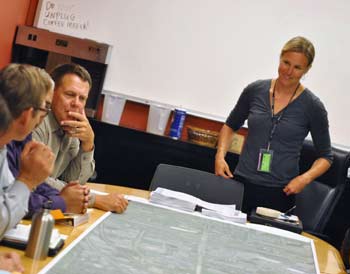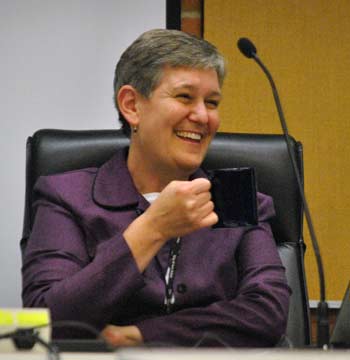Sustainability Goals Shape Corridor Study
Ann Arbor planning commission meeting (Sept. 18, 2012): Two projects converged at the most recent planning commission meeting: A draft report of a South State Street corridor study, and next steps toward incorporating the city’s new sustainability goals into its master plan.

The Sept. 18, 2012 Ann Arbor planning commission work session focused on South State Street – an aerial map of the corridor is spread out on the table. To the right is Kristin Baja, who provided staff support for the project. She’ll be leaving the city to take a job in Baltimore, and was praised by commissioners for her work. (Photos by the writer.)
Eric Mahler recalled that both projects had been highlighted at a planning commission retreat two years ago, and that in some ways their completion marked a new era in city planning. The corridor study is the first project that incorporates the sustainability goals. The study’s recommendations are organized into the four main sustainability categories: resource management; land use and access; climate and energy; and community.
The recommendations themselves cover a wide spectrum of issues, from traffic and walkability to public art and zoning. [.pdf of draft report] Planning commissioners spent nearly two hours reviewing the recommendations in a working session immediately following their regular Sept. 18 meeting. They’ll likely address the project again before it’s forwarded to city council.
Also during the Sept. 18 meeting, planning manager Wendy Rampson reviewed highlights from an annual report of planning activities for the fiscal year 2012, which ended June 30, 2012. The report reflected an increase in development activity within the city. As one example, there were 28 site plans submitted during the year, up from 13 in FY 2011.
Several University of Michigan students attended the commission’s regular meeting on Sept. 18. Responding to a query from Tony Derezinski, they reported that they are graduate students in urban planning, taking a class from professor Dick Norton. Coming to this meeting had been part of a class requirement. [Norton had also been a speaker on some of the panel discussions related to the city's sustainability efforts.]
Sustainability Framework
Planning commissioners were asked to recommend that the city council distribute Ann Arbor’s sustainability framework to neighboring jurisdictions, as the next step toward incorporating these goals into the city’s master plan. The commission had previously recommended approval of the 16 overarching sustainability goals, which are organized into four categories: resource management; land use and access; climate and energy; and community. [.pdf of sustainability document]
Wendy Rampson, the city’s planning manager, described the action as procedural. State law requires that changes to a community’s master plan must be communicated to adjacent jurisdictions and other stakeholders to allow the opportunity for feedback. The sustainability framework will be distributed to these entities: the planning commissions of Ann Arbor Township, Scio Township, Lodi Township and Pittsfield Township; the Barton Hills Village long-range planning committee; the Washtenaw County board of commissioners; the Southeast Michigan Council of Governments (SEMCOG); DTE Energy; Norfolk-Southern Railroad; the Ann Arbor Transportation Authority; the University of Michigan; and the Ann Arbor Public Schools board of education.
The planning commission will hold a public hearing – likely at one of its December 2012 meetings – for additional feedback. Entities more typically provide their input in written form.
Additional background on the Ann Arbor sustainability initiative is on the city’s website. See also Chronicle coverage: “Building a Sustainable Ann Arbor,” “Sustaining Ann Arbor’s Environmental Quality,” “Land Use, Transit Factor Into Sustainability,“ and “Final Forum: What Sustains Community?”
Sustainability Framework: Commission Discussion
Several commissioners praised the work that’s been done by staff to develop the framework. Ken Clein noted that it balances the need to be specific while not becoming an action plan. Having this as a part of the master plan sends a strong message about the importance of sustainability, he said. Clein also mentioned that he’d like to see more emphasis on the re-use of existing buildings.
Eric Mahler said it didn’t seem very long ago that the different commissions had started brainstorming on this project. It’s important to note that this framework is not set in stone, he added. He hoped that in the future the city could become even more aggressive in its sustainability goals, he added, so that it becomes part of the culture and permeates everything they do.
Evan Pratt highlighted the fact that this framework is actually a reorganization of more than 200 existing goals in various city plans. He appreciated the public process that had been involved in putting this framework together, and the thoughtfulness of its organization.
Outcome: Commissioners unanimously voted to distribute Ann Arbor’s sustainability framework to neighboring jurisdictions.
South State Street Corridor Study
Kristin Baja, project director for the city’s South State Street corridor study, updated commissioners about the status of that project. A written report has been drafted, and she’s seeking input before bringing it forward for approval. [.pdf of draft report]
It’s the next step in a project that’s been in the works for years. The plan includes more than 40 overall recommendations for the corridor, which stretches about 2 miles between Stimson Street at the north end down to Ellsworth in the south.
Recommendations are organized into categories of the city’s recently adopted sustainability framework: Land use and access, community, climate and energy, and resource management.
Among the recommendations are: (1) Evaluate use of vacant parcels for alternative energy generation; (2) Evaluate integrating public art along the corridor; (3) Evaluate use of open land for community gardens; (4) Assess and improve high crash areas along the corridor; (5) create boulevard on State Street between Eisenhower and I‐94 to enable safer automobile, bicycle, and pedestrian movement; (6) Consider utilizing vacant parcels for athletic fields and recreation facilities; (7) Develop a pedestrian and bicycle path along the Ann Arbor railroad that will connect the planned Allen Creek bikeway to Pittsfield Township through the corridor; and (8) Resurface roads in the corridor.
Each recommendation includes several related action items. The report also provides a section that organizes the recommendations into each of three distinct sections of the corridor: (1) from Stimson on the north to Eisenhower Parkway; (2) from Eisenhower south to the I-94 interchange; and (3) from I-94 to Ellsworth. In addition, there are nine site-specific recommendations for areas including Briarwood Mall, the complex of hotels near Victors Way and Broadway, and the research park development near the corridor’s south end.
The city planning commission and staff have been discussing this project for several years, but have ramped up action on it within the past 12-18 months. See Chronicle coverage: “South State Corridor Gets Closer Look.”
Baja told commissioners that the project’s next steps include finalizing the recommendations and report, holding a public hearing at a future planning commission meeting, and forwarding it to the city council for approval.
South State Street Corridor Study: Commission Discussion, Work Session
Several commissioners praised the work. Bonnie Bona noted that several projects had been proposed in the State Street area that differed from what the city’s master plan and zoning ordinance allowed. This study had been long-awaited, she said, and she’s eager to delve into the details of the proposed changes.
Tony Derezinski talked about the context of this study in relation to other corridor improvement efforts, including Reimagining Washtenaw Avenue and the North Main/Huron River task force that city council created earlier this year. He also noted that originally, the city had set aside funding for a consultant to do the South State Street study, but the council later decided not to expend those funds. The staff had moved forward with it instead, and the results are amazing, he said. One priority of these efforts is to beautify the entrances to the city, Derezinski said. As he has done several times in the past, he mentioned the possibility of partnering with the Rotary Club.
Eric Mahler said it was fortuitous that both the sustainability framework and the South State study were coming to the planning commission at the same meeting. At the commission’s retreat a couple of years ago, they had talked about getting both of these projects off the ground, he recalled, and layering the sustainability goals over the corridor study. [For Chronicle coverage of that retreat, see: "Ann Arbor Planning Priorities Take Shape."] This corridor study, with its incorporation of the sustainability goals, marks a new era of planning for the city, he said.
After the commission’s regular meeting adjourned, the group spent nearly two hours in a work session reviewing the draft report of the South State corridor study. The wide-ranging discussion was followed by a round of applause for Baja, who’ll be leaving the city to take a job in Baltimore next month.
Annual Planning Activity Report
During the commission’s regular meeting on Sept. 18, Wendy Rampson, the city’s planning manager, reviewed highlights from an annual report of planning activities for the fiscal year 2012, which ended June 30, 2012. She told commissioners that it would give them an idea about how the planning staff spends its time. [.pdf of annual activity report]
Planning staff provided support for 70 meetings during the year, which Rampson noted takes a substantial amount of time and energy. The staff’s historic district activities included reviewing 157 applications, up 31% from 120 in FY 2011. The staff also reviewed 895 building permits to check for zoning compliance, compared to 756 permits in FY 2011 – an increase of 18%. These items include things like building additions to single-family houses or renovations in rental properties.
For development reviews – the kinds of projects that come before the planning commission – there was a sharp increase, too. The staff handled 13 zoning/planned unit development applications, compared to just one the previous year. There were 28 site plans submitted, up from 13 in FY 2011.
Sometimes it’s hard to make comparisons from year to year based on the number of applications, Rampson said, because some projects are more complicated than others and therefore take more time to handle. But there’s no doubt that during the last fiscal year, the staff spent more time on development review, she said.
This report will be forwarded to city council as an item of information.
Present: Eleanore Adenekan, Bonnie Bona, Ken Clein, Tony Derezinski, Diane Giannola, Eric Mahler, Evan Pratt, Kirk Westphal.
Absent: Wendy Woods.
Next regular meeting: Tuesday, Oct. 2, 2012 at 7 p.m. in the second-floor council chambers at city hall, 301 E. Huron St., Ann Arbor. [Check Chronicle event listings to confirm date]
The Chronicle relies in part on regular voluntary subscriptions to support our coverage of public bodies like the city planning commission. If you’re already supporting The Chronicle, please plan to encourage your friends, neighbors and coworkers to do the same. Click this link for details: Subscribe to The Chronicle.





